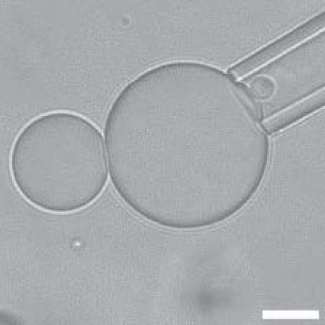
Crystallography: Electron diffraction locates hydrogen atoms
Diffraction-based analytical methods are widely used in laboratories, but they struggle to study samples that are smaller than a micrometer in size. Researchers from the Laboratoire de cristallographie et sciences des matériaux (CNRS/Ensicaen/Unicaen), the Laboratoire catalyse et spectrochimie (CNRS/Ensicaen/Unicaen)1 , and the Academy of Sciences of the Czech Republic have nevertheless been successful in using electron diffraction to reveal the structure of nanocrystals2 . Their method is so sensitive that it has even located the position of hydrogen atoms for the first time, which is crucial in accessing the morphology of the molecules or the size of cavities in porous materials. This research, published on January 13, 2017, has made the front page of the journal Science.
- 1This research originated with a research project financed by the Normandy-based Labex EMC3. Within this framework, researchers from the CRISMAT (P. Boullay, O. Pérez and S. Petit), the LCS (S. Mintova and M. Zaarour) and L. Palatinus from the Academy of Sciences of the Czech Republic synthesized and then resolved the structure of cobalt aluminophosphate.
- 21 micrometer (µm) = 10-6 meters (i.e. a millionth of a meter) and 1 nanometer (nm) = 10-9 meters (i.e. a billionth of a meter).
Diffraction of X-rays or neutrons by crystals is a method of choice for obtaining the atomic structure of crystalline solids essential for understanding the properties of materials, reactional mechanisms or biomolecules like proteins or DNA. However, this technique requires crystals of the order of a micrometer, in the case of X-rays, and of a millimeter, in the case of neutrons. Electron diffraction enables the study of nanosized samples, thanks to the strong interaction with the material of these charged particles. The downside is that multiple diffractions occur and reduce the quality of the results obtained. In the kinematical theory of diffraction, it is assumed that the diffracted particles undergo a single diffraction event. This approximation considerably simplifies analyses for X-rays and neutrons, but does not work for electrons. It is therefore necessary to use the dynamical theory of diffraction, which takes into account the fact that electrons can be diffracted several times. This requires a specific form of processing, and a long and complex analysis.
Thanks to a new application of the dynamical theory to the analysis of electron diffraction data, it has been possible to determine the structures of an organic compound, paracetamol, and an inorganic compound, a cobalt aluminophosphate. The remarkable sensitivity of this method makes it possible to reveal the position of even the lightest atoms, i.e. hydrogen atoms. Their position is crucial in accessing the morphology of organic molecules, weak interactions in the material, and the size of cavities in porous inorganic materials. By localizing hydrogen atoms, it is demonstrated that the structure of the numerous compounds that form only very small crystals can now be resolved in its fine detail. This research paves the way to a wide use of electron diffraction to determine the structure of crystals that cannot be accessed by X-ray or neutron diffraction.

Representation of the structure of a cobalt aluminophosphate, superimposed onto a map showing maxima (in yellow) associated with the hydrogen positions, after analysis of the electron diffraction data.
Hydrogen positions in single nanocrystals revealed by electron diffraction, L. Palatinus, P. Brázda, P. Boullay, O. Perez, M. Klementová, S. Petit, V. Eigner, M. Zaarour and S. Mintova, Science, January 13, 2017. DOI: 10.1126/science.aak9652


